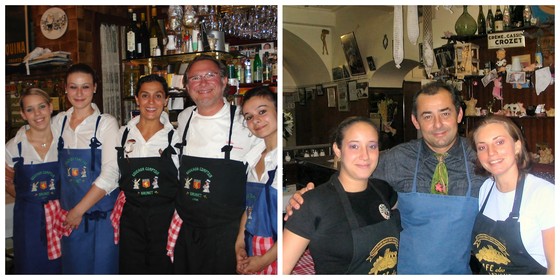Two "truculent" restaurant owners, of patrons and their waitstaff in Lyon. Left: Gilles Maysonnave at Brunet. Right: Yves Rivoiron at Café des Fédérations.
In English, calling someone truculent is sort of like a French person calling someone a cornichon. We think of truculent people as obstinate assholes, abrasive and obstructionist, not particularly nasty but (at best) still kind of a jerk. "Cornichon," in case you were wondering, is a polite way of calling someone "un con"--an asshole or worse.
Well, flip that concept, language-wise, for truculent. In French, it's a compliment; it means "colorful," "larger than life," someone with an outsize personality (game show hosts, used-car salesmen, TV evangelists, and, yes, The Donald) without the downside of insincerity. In other words, someone like the legendary Paul Bocuse, or almost any of the charismatic hosts of a bouchon. In Lyon, truculence is at the heart of hospitality.
Now, before you get the idea that the bouchons are sexist relics of a misogynist past, you should be aware that the reputation of Lyon as the epicenter of French gastronomy is based on its "mothers." La Mère Blanc (whose son, Georges, runs a Michelin three-star kitchen outside Lyon); la Mère Brazier (a first: three Michelin stars each for two separate restaurants!); la Mère Léa; whose former coaching station in the center of Lyon is operated as a bouchon by its new proprietor, the celebrity chef Christian Tetedoie; and easily a dozen more. What we think of today as "typical" Lyon cuisine (the pigs trotters, the sausages, the quenelles, the stews of tripe) originated with these mothers, who coaxed every last bit of flavor from the least expensive ingredients. And whether you ate high on the hog (loin, chop, roast) in a classy spot, or worked your way down (to belly, feet, ears, or tail) in a bouchon, you would find the best eating in France at the confluence of the Saône and the Rhône.
Another reason was the large number of silk workers who operated the first world's first mechanized looms in factories built on the slopes of Lyon's Croix Rousse hill. Poorly paid and hungry, they would frequent bouchons for their morning mâchons of andouillette (tripe sausages) and cervelle de canuts (fresh cheese with garlic and chives).
Hence the popularity of the bouchons and their aromas of long-simmering gras double in an onion-scented court-bouillon. There's an association of officially sanctioned "authentic" bouchons, promulgated by the Lyon Chamber of Commerce and the Lyon Visitor Bureau, set up to recognize the most deserving of the city's 300 bouchon wannabes, including restaurants that claim to be real bouchons but just serve a couple of safe-for-tourists items (sautéed calf liver). There are 24 officially designated bouchons in Lyon plus three in Paris (one of them run by Alain Ducasse), and half again as many who deserve to be on the list but were dropped for political reasons. Brunet is in, but the Café des Fédérations is among those out in the cold.
In addition to the two dozen officially recognized restaurants, there's a separate category for officially sanctioned "partners." Now anyone who's ever been involved in an industry association knows that it's the corporate "sponsors" who pay the freight. The most famous names: the cheesemonger Renée Richard of La Mère Richard, and wine powerhouses Georges Duboeuf and Chapoutier. There are also suppliers of coffee, mineral water, ice cream, the properly handled offal that's at the base of so much of the bouchon cooking. There's even an official fruit juice. (Fruit juice is authentic? Fruit juice is a red flag, if you ask me.) I'm glad that the guy at the helm of the Chamber of Commerce tourism committee, Christophe Marguin, is taking full responsibility for this fiasco. Best of intentions, of course, best of intentions.
Note: I've been holding this back for a week, awaiting some sort of comment from the bureaucrats in Lyon. No response, so I'll run with it.

Leave a comment